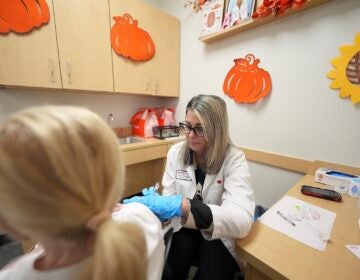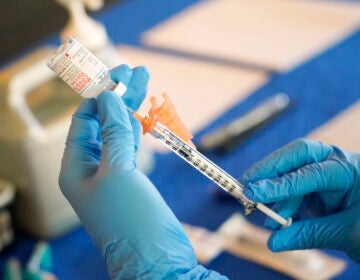‘Pacing’ for long COVID can help people cope, but there’s a tradeoff
Chronic fatigue associated with long COVID forces many people to rest and disengage from activities they used to do — but limiting your life can feel powerless.
Listen 8:44
Fatigued and exhausted girl holding head. (Big Stock Image/LogotypeVector)
This story is from The Pulse, a weekly health and science podcast.
Find it on Apple Podcasts, Spotify, or wherever you get your podcasts.
Editor’s note: We’re calling the main subject in this story “Susana” to protect her privacy.
When Susana was growing up, she was pretty much an only child. Her two siblings were much older than her, and she often found herself roaming the world on her own and fending for herself.
“I was a latchkey kid,” she said. “And I think that when you grow up in that kind of environment, you kind of just feel like… you don’t need anybody else’s help.”
Susana eventually grew into a self-sufficient individual. She often carried out activities independently and avoided the need to ask for help. And as her personality blossomed, she became much of an adventurer — constantly interested in challenging hikes and roller derby competitions.
She thought of herself as daring. “I like to prove people wrong. If somebody tells me I can’t do something, I will show them I can.”
But this all changed in 2021 when Susana got a mild case of COVID-19, which later led to long COVID.
“I was practically bedridden for the first few weeks,” she said. “It was hard for me to lift my arms up. Then it was hard for me to sit up, and it was hard for me to eat.
Subscribe to The Pulse
Susana was experiencing chronic fatigue that usually led to excruciating pain if she tried to fight it. Her persistent symptoms proved to be a significant inconvenience in her life.
By the third month of her symptoms, she saw a specialist at the Post-COVID Assessment and Recovery Clinic at Penn Medicine in Philadelphia. The clinic was established in March 2021 to provide care for patients experiencing lingering side effects from a COVID-19 infection and to study the nature of long COVID.
“I expected an answer,” she said. “I expected to hear this is what’s happening to you, here’s how we treat it, and this is how long you can expect to get better. And that’s definitely not what happened.”
For Susana’s symptoms, the post-COVID clinic was unable to offer her a ‘cure-all’ treatment — but they did suggest ways to manage her fatigue. One was called pacing — as in pace yourself. It’s a long COVID strategy where the patient is active when they’re able and resting when they’re tired — rather than pushing through their symptoms.
Pacing sounds simple enough, but the strategy forces patients to quit activities that many people take for granted — like chopping vegetables for dinner or pushing a heavy door open. It’s like making a list of things to do and crossing off half of the list based on the amount of energy you have.
Susana tried it out. She no longer walked her dog as much as she wanted to, and she stopped making long grocery lists so that she could actually carry the items back home. She also retired from one of her favorite and satisfying hobbies, assembling Ikea furniture.
But there were times when pacing fell short. When she was totally exhausted — she had to ask for help — which was a difficult task for her. The independence Susana had embodied for most of her life was slipping away while she was coping with the effects of long COVID.
“Having long COVID takes all of that away,” she said. “Not just like the physical, fitness aspect, but like really being in control of your body and being independent.”
As months passed, Susana began to feel better. Her fatigue had lessened, and she could resume most activities after almost a year. It’s unclear if pacing helped with her symptoms as research is still being conducted on the method and its effectiveness on long COVID.
But then, history repeated itself.
Susana came down with COVID-19 again and began to develop a different long COVID symptom. She began to experience nerve damage. Her body gave her little to no warning when it was going to give out. At one point, when Susana was preparing for a Superbowl party, her nerve injury caused her to collapse.
Susana received medication to help ease her symptoms but had to resume pacing..
She began to wonder how she could cope with her symptoms this time around without feeling so powerless. It all culminated one night when Susana faced a dilemma: wash her hair or cook dinner.
Susana works in an office where appearances are important. Her hair has to be neat and clean. She often tries styles where it’s pulled back in braids, styles that require long periods of time with her arms above her head. But Susana also had to eat. Since enduring long COVID, she has always had trouble cutting vegetables or even stirring ingredients in a bowl.
She chose dinner.
“And, I just had a moment where I was like, ‘You know what? I’m just going to cut my hair off,’” she said. ” ‘I can’t live like this anymore. I can’t live constantly in pain, struggling to do little things.’”
Susana booked an appointment with a salon. The stylist tried to talk her out of it, but Susana persisted, saying that it would be the most practical choice even if she didn’t like it.
Deep down, Susana was preparing herself to cry and become overwhelmed with sadness as the service began. She thinks of herself as introverted and shy. Susana thought losing her shag-styled hair would mean there would be nothing else to hide behind.
But Susana felt other emotions once her hair was cut — some she hadn’t felt in a while.
“I felt trapped and beholden to my body. And cutting my hair, it was just powerful. It was like regaining that power.”
A haircut didn’t relieve her symptoms, but it did become a hallmark, a reminder that she was able to gain some independence during a challenging time.
For people like Susana, there are currently no proven methods of treatment for long COVID — and she says her time is better spent on what she can do to make her life easier.
“I can’t focus on solutions with long COVID because, to me, there aren’t any,” she says. “So, I just have to focus on, like, what I’m able to do. And then, when I get to a point where I can’t do it anymore, I have to be okay with not doing it.”
WHYY is your source for fact-based, in-depth journalism and information. As a nonprofit organization, we rely on financial support from readers like you. Please give today.







